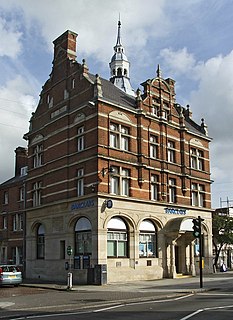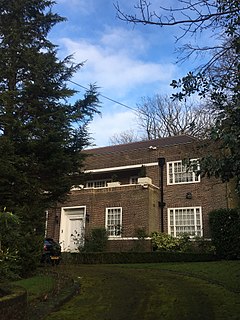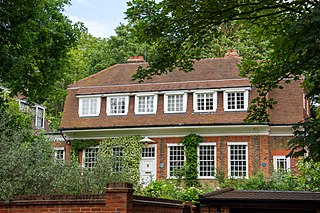
Sir George Gilbert Scott, known as Sir Gilbert Scott, was a prolific English Gothic revival architect, chiefly associated with the design, building and renovation of churches and cathedrals, although he started his career as a leading designer of workhouses. Over 800 buildings were designed or altered by him.
John Oldrid Scott was a British architect.

Sir Arthur William Blomfield was an English architect. He became president of the Architectural Association in 1861; a Fellow of the Royal Institute of British Architects in 1867 and vice-president of the RIBA in 1886. He was educated at Trinity College, Cambridge, where he read Architecture.
Samuel Sanders Teulon was a 19th-century English Gothic Revival architect, noted for his use of polychrome brickwork and the complex planning of his buildings.

Wappenham is a linear village and civil parish in Northamptonshire, England. It is 5 miles (8 km) south-west of Towcester, north of Syresham and north-west of Silverstone and forms part of West Northamptonshire. At the time of the 2001 census, the parish's population was 266 people, increasing to 294 at the 2011 Census.

Ewan Christian (1814–1895) was a British architect. He is most notable for the restorations of Southwell Minster and Carlisle Cathedral, and the design of the National Portrait Gallery. He was Architect to the Ecclesiastical Commissioners from 1851 to 1895. Christian was elected A RIBA in 1840, FRIBA in 1850, RIBA President 1884–1886 and was awarded the Royal Gold Medal in 1887.
Benjamin Ferrey FSA FRIBA (1810–1880) was an English architect who worked mostly in the Gothic Revival.

The Ossulston Estate is a multi-storey council estate built by the London County Council on Chalton Street in Somers Town between 1927 and 1931. It was unusual at the time both in its inner-city location and in its modernist design, and all the original parts of the estate are now Grade II listed buildings.

The Old Pack Horse is a Grade II listed public house in a prominent position on the corner of Chiswick High Road and Acton Lane in Chiswick, London.
Leslie Gooday OBE (1921–2013) was a British architect.
Arthur Edward Sewell (1872–1946) was an English architect, particularly known for the public houses he designed whilst working as the in-house architect for Truman's Brewery. His career peaked in the 1920s and 1930s, and at least five pubs that he designed in that period are now listed buildings with Historic England. In all, he designed around 50 pubs.

William Gillbee Scott, sometimes William Gilbee Scott, (1857-1930) was an English architect who designed the Gower Street Memorial Chapel, the Salvation Army Citadel in Sheffield, and the London and Provincial Bank in Enfield.

The Croft is a large detached house on Totteridge Green in Totteridge, Barnet. It has been Grade II listed on the National Heritage List for England since November 1974.

Spaniards Mount at 61 Winnington Road in Hampstead Garden Suburb, London is a detached house that was designed by the architect Adrian Gilbert Scott as his personal residence. It was built in 1935 and has been Grade II listed on the National Heritage List for England since November 1996.
Shepherd's Well at 5 Frognal Way in Frognal, London is a detached house that was designed by the architect Adrian Gilbert Scott as his personal residence. It was built between 1929 and 1930 and has been Grade II listed on the National Heritage List for England since January 1999.

One Oak at 16 Redington Road in the Frognal area of Hampstead, London NW3, is a detached house built in 1889 by the architect Arthur Heygate Mackmurdo. The house has been listed Grade II on the National Heritage List for England since January 1999.

John Dixon Butler was a British architect and the Surveyor to London's Metropolitan Police from 1895 until his death. He completed some 200 buildings during his career, mostly for the police, including ten courts; about 58 of his buildings survive. Historic England have included around 25 of these buildings on the National Historic List of England and Wales.











